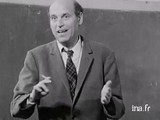Yona Friedman regarding the machine that invents flats

Information
Yona Friedman, an architect born in Hungary, explains a project she conceived for an Osaka exhibit in 1970. Visitors of this exhibit will be able to choose their flat's layout and its location, and build their own town, which will be projected onto a screen as it is designed.
Context
Utopian architect and Hungarian theoretician, Yona Friedman published more than he built. He participated in the development of the first residential Israeli colonies before developing, through his child-like drawings, an "achievable utopia" who's success depended on the will of the people. In response to problematic urban displacement, the central theme of the 10th CIAM congress, he proposed to put in place a "mobile architecture" composed of flexible autonomous compartments capable of carrying out constant transformations in order to insure social mobility. These cells attach freely to any point of a mega-structure raised 35 metres off the ground, supported by pylons of vertical circulation and guaranteeing connections for the necessary fluids.
The "Spatial City" conciliated mass-production and "habitat decided by inhabitant" while advocating "auto planning", leaving an open court for user improvisation. This framework, after having defined a "continent city" then a "private town", would become a "town of the third millennium", with a minimal impact on the countryside, using materials available on location, freeing the ground to enable its exploitation. Seasonal towns with migrating inhabitants save energy while offering an ideal way of life. At 95 years old, he showed a series of bridges over the Yang Tse Tiang, intertwined superstructures that house populations displaced by the rising of the waters.

















